Advertisements
Advertisements
प्रश्न
In a ABC , AD is a median and AL ⊥ BC .
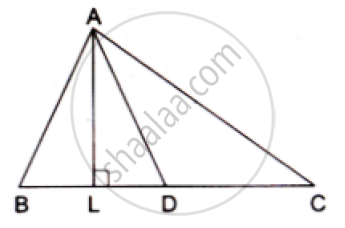
Prove that
(a) `AC^2=AD^2+BC DL+((BC)/2)^2`
(b) `AB^2=AD^2-BC DL+((BC)/2)^2`
(c) `AC^2+AB^2=2.AD^2+1/2BC^2`
उत्तर १
(a) In right triangle ALD
Using Pythagoras theorem, we have
`=AC^2-AL^2+LC^2`
`=AD^2-DL^2+(DL+DC)^2 ` [Using (1)]
=`AD^2-DL^2+(DL+(BC)/2)^2` [∵ AD is a median]
`=AD^2-DL^2+DL^2+((BC)/2)^2+BC.DL `
∴` AC^2=AD^2+BC.DL+((BC)/2)^2` .................(2)
(b) In right triangle ALD
Using Pythagoras theorem, we have
`AL^2=AD^2-DL^2` ....................(3)
Again, In right triangle ABL
Using Pythagoras theorem, we have
`AB^2=AL^2+LB^2`
`=AD^2-DL^2+LB^2` [𝑈𝑠𝑖𝑛𝑔 (3)]
उत्तर २
(a) In right triangle ALD
Using Pythagoras theorem, we have
`=AC^2-AL^2+LC^2`
`=AD^2-DL^2+(DL+DC)^2 ` [Using (1)]
=`AD^2-DL^2+(DL+(BC)/2)^2` [∵ AD is a median]
`=AD^2-DL^2+DL^2+((BC)/2)^2+BC.DL `
∴` AC^2=AD^2+BC.DL+((BC)/2)^2` .................(2)
(b) In right triangle ALD
Using Pythagoras theorem, we have
`AL^2=AD^2-DL^2` ....................(3)
Again, In right triangle ABL
Using Pythagoras theorem, we have
`AB^2=AL^2+LB^2`
`=AD^2-DL^2+LB^2` [𝑈𝑠𝑖𝑛𝑔 (3)]
=`AD^2-DL^2+(BD-DL)^2`
=`AD^2DL^2+(1/2BC-DL)^2`
=`AD^2-DL^2+((BC)/2)^2-BC.DL+DL^2`
∴ AB^2=AD^2-BC.DL+((BC)/2)^2 .............(4)
(c) Adding (2) and (4), we get,
=`AC^2+AB^2=AD^2+BC.DL+((BC)/2)^2+AD^2-BC.DL+((BC)/2)^2`
=`2AD^2+(BC^2)/4+(BC^2)/4`
=`2AD^2+(BC^2)/4+(BC^2)/4`
=`2AD^2+1/2BC^2`
APPEARS IN
संबंधित प्रश्न
In ΔABC, D and E are points on the sides AB and AC respectively such that DE || BC
If AD = 2.5 cm, BD = 3.0 cm and AE = 3.75 cm, find the length of AC.
In a ΔABC, D and E are points on the sides AB and AC respectively. For the following case show that DE || BC
AB = 5.6cm, AD = 1.4cm, AC= 7.2 cm and AE = 1.8 cm.
In a ΔABC, D and E are points on the sides AB and AC respectively. For the following case show that DE || BC
AD = 5.7 cm, BD = 9.5 cm, AE = 3.3 cm and EC = 5.5 cm.
D and E are points on the sides AB and AC respectively of a ΔABC such that DE║BC.
If AB = 13.3cm, AC = 11.9cm and EC = 5.1cm, find AD.
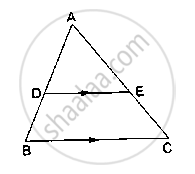
D and E are points on the sides AB and AC respectively of a ΔABC such that DE║BC.
If` (AD)/(AB) = 8/15 and EC = 3.5cm`, find AE.
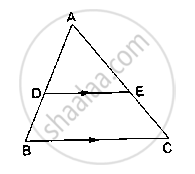
A and B are respectively the points on the sides PQ and PR of a triangle PQR such that PQ = 12.5 cm, PA = 5 cm, BR = 6 cm and PB = 4 cm. Is AB || QR? Give reasons for your answer.
Prove that If a line is drawn parallel to one side of a triangle to intersect the other two sides in distinct points, the other two sides are divided in the same ratio. In the figure, find EC if `(AD)/(DB) = (AE)/(EC)` using the above theorem.

In the given figure, ABC is a triangle in which DE||BC. If AD = x, DB = x – 2, AE = x + 2 and EC = x – 1, then find the value of x.
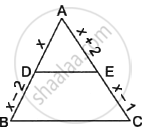
In the given figure ∠CEF = ∠CFE. F is the midpoint of DC. Prove that `(AB)/(BD) = (AE)/(FD)`
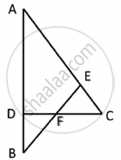
State and prove Basic Proportionality theorem.
